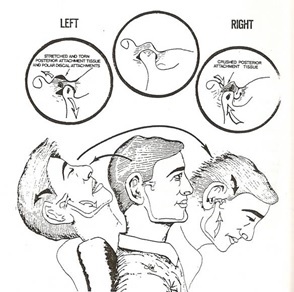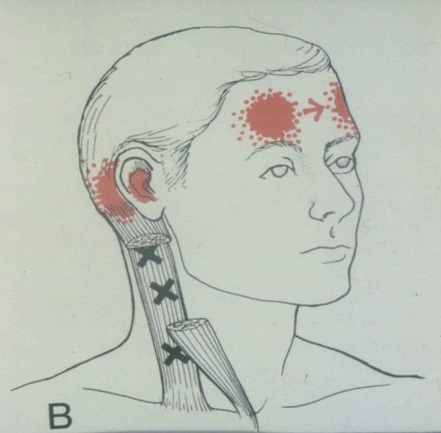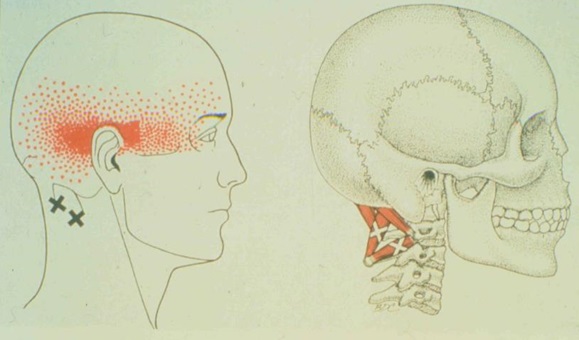Neck affects jaw-ear-head:
Science of joint muscle complex, like cervical dysfunction, is orthopedics.
Treatment of Cervical Dysfunction, Chewing System Dysfunction, or Multisource Inflammation Headaches by solo practitioners is woefully inadequate due:
Pains from neighboring structures affect TMD:
Cervical dysfunction:
Damage in neck system ( DJD )
Neck discomfort:
Neck contraction causes Jaw contraction
Reciprocal contraction:
Chewing system-------------------
Hyoid-----------------------------
Jaw’s muscle brace----------------
Subhyoid”s brace------------------
Suprahyoid brace---------
Neck muscle brace--------
Trauma

Tearing fibers of disc of cervical vertebrae
Posturing
Bracing
Repetitive motion
Tension
Phone shoulder
Falls
Posturing
Blow
MVA
At some point, the extent of accumulative damage to disc-cervical joint-vertebrae causes instability/dysfunction/pain creating a source of inflammation & reciprocal contraction in neighboring systems.
Damage cervical system:
A microtrauma like whiplash injury can macrotear fibers ligaments to cervical vertebrae; whereas, an ongoing tension or posturing in muscles causes microtear to fibers of cervical vertebrae.
Cervical muscle damage is revealed:
Enlargement muscles
Trigger points in muscles
Trigger points in neck refer to other structures:


Posturing head
Tale twin sisters:
MVA occurs with twin sisters in back seat car w/ seat belt
First sister is cardiovascular conditioned
Second sister is decondition
1st sister enjoys neck pain for week,
2nd sister enjoys neck pain lifetime
Comorbid Conditions
Neck affects jaw-ear-head:
Science of joint muscle complex, like cervical dysfunction, is orthopedics.
Treatment of Cervical Dysfunction, Chewing System Dysfunction, or Multisource Inflammation Headaches by solo practitioners is woefully inadequate due:
Pains from neighboring structures affect TMD:
Cervical dysfunction:
Damage in neck system ( DJD )
Neck discomfort:
Neck contraction causes Jaw contraction
Reciprocal contraction:
Chewing system-------------------
Hyoid-----------------------------
Jaw’s muscle brace----------------
Subhyoid”s brace------------------
Suprahyoid brace---------
Neck muscle brace--------
Trauma

Tearing fibers of disc of cervical vertebrae
Posturing
Bracing
Repetitive motion
Tension
Phone shoulder
Falls
Posturing
Blow
MVA
At some point, the extent of accumulative damage to disc-cervical joint-vertebrae causes instability/dysfunction/pain creating a source of inflammation & reciprocal contraction in neighboring systems.
Damage cervical system:
A microtrauma like whiplash injury can macrotear fibers ligaments to cervical vertebrae; whereas, an ongoing tension or posturing in muscles causes microtear to fibers of cervical vertebrae.
Cervical muscle damage is revealed:
Enlargement muscles
Trigger points in muscles
Trigger points in neck refer to other structures:


Posturing head
Tale twin sisters:
MVA occurs with twin sisters in back seat car w/ seat belt
First sister is cardiovascular conditioned
Second sister is decondition
1st sister enjoys neck pain for week,
2nd sister enjoys neck pain lifetime
Comorbid Conditions

 Raleigh Facial Pain © 2024 All Rights Reserved.
Raleigh Facial Pain © 2024 All Rights Reserved.